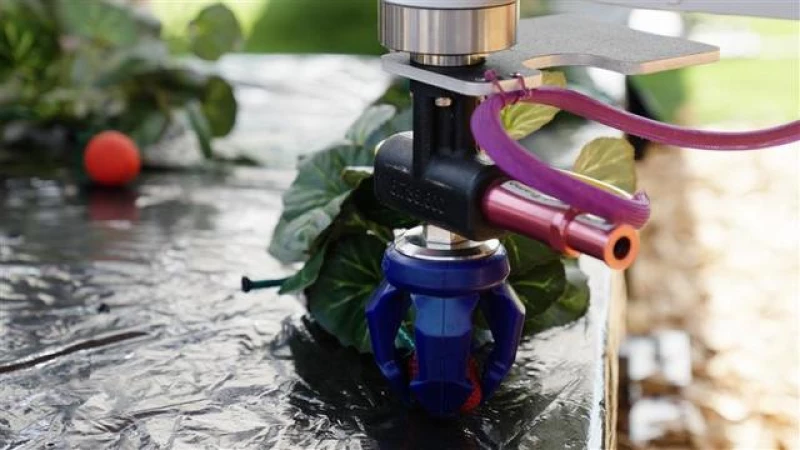The future of farming is here - with drones and robots taking over the cultivation and processing of fruits and vegetables. These high-tech machines, some powered by artificial intelligence, are already in action on farms throughout America.
A Houston-based tech company, Hylio, recently received an exemption from the Federal Aviation Administration to operate swarms of heavy drones over farms. These battery-powered drones, some weighing up to 400 pounds each, are now being used to spray fertilizer and pesticides on produce fields. This task, traditionally done by farm workers or crop-dusting planes, is now being revolutionized by technology.
Prior to the FAA's decision, operating a drone swarm like this would have required a team of licensed operators, making the process complex and costly. With the new exemption, one operator can control three drones simultaneously, covering 150 acres in just one hour.
"The exemption we received is groundbreaking," said Hylio CEO Arthur Erickson. "Our customers and other companies can now follow suit and obtain similar permissions."
From drones to lasers to robotic "hands"
At the World Agriculture Expo in Tulare in February 2024, crop-dusting drones were just one of the many advanced agricultural technologies showcased. The future of farming is evolving rapidly with the integration of drones, lasers, and robotic systems.
Over 1,250 exhibitors graced this year's Expo, attracting more than 100,000 visitors. Attendees witnessed demonstrations of various products, including an autonomous crop sprayer and an AI-powered robot designed to delicately pick berries using a silicone "hand."
"Every farmer will eventually become a coder," remarked Ethan Rublee, the mind behind farm-ng. His company showcased the Amiga, an all-electric, robotic micro-tractor equipped with AI components that can be programmed to perform tasks like hauling equipment, seeding, cultivating, and spreading compost for extended periods on a single charge.
Hailing from Watsonville, just an hour away from San Jose, Rublee's company has attracted attention from investors in Silicon Valley.
"We've secured a total of $16 million in funding over the past four years," he stated. "With $10 million in the bank and a team of 30 talented individuals, we are on a mission to revolutionize agriculture."
Paul Mikesell, the CEO and founder of Carbon Robotics, unveiled the Laser Weeder at the event. This innovative device utilizes powerful infrared lasers and high-speed cameras to detect and eliminate weeds within seconds.
"Before the Laser Weeder, manual labor and chemical spraying were the norm for weed control," explained Mikesell.
Could this be a solution for the labor shortage?
Developers of these high-tech tools said their inventions could help ease the decadeslong labor shortage that's been impacting the U.S. agricultural industry. Between 1950 and 2000, the number of hired farm laborers declined by more than 50%, according to data from the U.S. Department of Agriculture. Hiring has continued to be a challenge for farm owners into the 2020s.
While the shift towards automation could offset the labor shortage and relieve farm workers of some arduous, monotonous and at times dangerous tasks, 61-year-old farm worker Lulu Cardenas fears this new technology will put her job at risk.
"I feel replaced by something like that," said Cardenas. "I'm going to have a hardship to help my family."
She has worked the fields in California's Central Valley since immigrating from Mexico 20 years ago. When CBS News described the new kinds of farm robots to Cardenas, she was disappointed, citing the spiritual connection between humans and plants.
"You cannot replace human heat with a cold machine," she said.
Cardenas' friend Asuncion Ponce, who came from her same village just south of Mexico City 36 years ago, was also upset when he saw images of the new farm robots.
"The farmers benefit from it, but they're taking a lot of work from us," said Ponce, who just became a U.S. citizen.
He has already seen equipment take over some work on the farm, but this was his first time seeing the new crop of "thinking" machines.
With advancements in technology, the agricultural industry is seeing a shift towards automation. "There's a lot of machinery that now harvests onion, garlic, lettuce, broccoli," Ponce said. "Instead of more people laboring, now you're having three people."
Some large-scale farms and advocacy groups have initiated training programs to help farm workers acquire the skills needed to adapt to this new technology. They are being trained to take on roles such as drone operators or programmers.
"I think that we can use machinery and still take care of our people," said Adrián Miramontes, a Mexican immigrant and military veteran who now manages a large farming operation. "They're willing to learn and they're willing to do better for themselves and their families."
The next steps
The U.S. Department of Labor is actively monitoring the situation. A spokesperson mentioned that next month, the department will present President Biden with a list of recommendations for an aid program that could assist farm workers who have been displaced by AI. This aid package would need congressional approval and could potentially be included in a new Executive Order following one from October 2023.
It remains uncertain whether such an aid program would extend to the hundreds of thousands of undocumented immigrants working on American farms.







